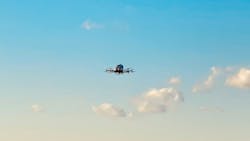United States automated vehicle policy announced at CES 2020
In this week’s roundup from the Association for Unmanned Vehicle Systems International, which highlights some of the latest news and headlines in unmanned vehicles and robotics, federal automated vehicle policy in the United States is further defined, autonomous air vehicle testing in North Carolina, USA, and artificial intelligence plans for remotely operated vehicles.
Sec. Chao releases version 4.0 of federal AV guidelines
Secretary of Transportation Elaine Chao announced the fourth iteration of the federal automated vehicle policy during a keynote speech at CES 2020.
Named Automated Vehicles 4.0: Ensuring American Leadership in Automated Vehicle Technologies, the guidance streamlines federal guidance for 38 government agencies, departments, commissions and others, Chao said, and is aimed at maintaining highway safety while allowing development on AVs to flourish.
"The takeaway from AV 4.0 is that the federal government is all in for safer, better and more inclusive transportation, aided by automated driving systems," she said.
As was the case with the earlier versions, AV 4.0 does not pick winners and losers among specific technology.
Instead, it adheres to three key principles, she said: protect users and communities, such as by prioritizing safety and emphasizing cybersecurity and privacy; promoting efficient markets, including by protecting American intellectual property and streamlining regulations; and facilitating coordinated efforts, aimed at ensuring a consistent federal approach among the agencies and other bodies Chao mentioned.
"Automated vehicles can save thousands of lives annually," Chao said, and could also restore mobility for "for millions of people who face transportation challenges, such as the elderly or the disabled."
Chao also noted the Federal Aviation Administration recently released a notice of proposed rulemaking for remote identification of drones, which has "significant security implications" for the industry.
The recent operations of "mystery drones" flying at night over Nebraska and Colorado provide a timely reminder of the need for this system, Chao said.
The deadline for comments on the rule is March 2, 2020.
AV 4.0 was described as a joint venture between the White House and the DOT, and White House CTO Michael Kratsios spoke after Chao and noted that the White House has also released federal guidance on the development of artificial intelligence.
"This is a very, very big step both for the United States and the world," Kratsios said.
The guidance is aimed at promoting dialogue with industry, he said.
"We can't begin to blindly put out rules without interaction."
EHang conducts first U.S. trial flight of autonomous aerial vehicle in North Carolina
As part of the North Carolina Transportation Summit, EHang conducted its first-ever U.S. trial flight of the EHang 216, which is the company’s two-seater passenger-grade autonomous aerial vehicle (AAV).
Conducted on Tuesday, Jan. 7, the trial flight was the first time that the EHang 216 has received flight approval from the FAA. The trial flight was a non-passenger flight, but EHang says that it is working with the FAA to secure approval for a passenger trial flight of the EHang 216 “in the near future.”
“We are proud to have the first autonomous aerial vehicle flying in North America, in North Carolina,” says North Carolina Governor Roy Cooper.
“We want North Carolina to be on the cutting edge of this technology and we’re proud to have EHang here to show and demonstrate to us what can be done with this technology.”
Thus far, EHang has safely conducted more than two thousand trial flights across the world, including in China. As part of EHang's joint initiative with the government of Guangzhou, China to develop Guangzhou to be EHang’s first urban air mobility (UAM) pilot city, two EHang 216 AAVs completed simultaneous trial flights of their commercial sightseeing applications in Guangzhou late last year. EHang says that the flights will allow the company to test flight routes and vertiports to implement the initiative.
EHang notes that it is the first UAM company to realize commercialization for its passenger-grade AAVs, as the company has delivered 38 units to customers as of Dec. 5, 2019.
“Our mission is to make safe, autonomous, and eco-friendly air mobility accessible to everyone and this trial flight represents a significant step towards bringing our urban air mobility solutions to the U.S. market,” says EHang founder, chairman, and CEO Huazhi Hu.
“Pilotless air taxis have the power to transform everyday life in urban areas since they can lessen pollution, expedite emergency services, and save individuals and businesses time and money through shorter travel times.”
WHOI researchers develop AI-based automated planning software for ROVs
A team of Researchers at Woods Hole Oceanographic Institution (WHOI) has developed an artificial intelligence-based automated planning software for ROVs.
An existing WHOI vehicle known as Neried Under Ice (NUI) was recently equipped with the software, and as a result, was able to determine which sites to visit and obtain samples from those locations while exploring the Kolumbo submarine volcano off the coast of the Greek island of Santorini.
The WHOI team that developed the system was led by associate scientist Rich Camilli. The original code was written by Gideon Billings, a guest student from the University of Michigan. Billings remotely issued a command to NUI, and the ROV responded by using a slurp-sample hose on its manipulator arm to reach down and suck up seabed sediment from a precise location. This was described as a world-first, as a human operator would usually have to control all aspects of such a task.
"For a vehicle to take a sample without a pilot driving it was a huge step forward," Camilli says. "One of our goals was to toss out the joystick, and we were able to do just that."
Developed through NASA's Planetary Science and Technology from Analog Research (PSTAR) program, the system could one day be used to explore oceans on other planets. Until then, though, researchers are working on a natural-language interface that would allow scientists to communicate directly with autonomous ROVs, along with a network that would let multiple ROVs work together as a collaborative fleet.
Share your vision-related news by contacting Dennis Scimeca, Associate Editor, Vision Systems Design
SUBSCRIBE TO OUR NEWSLETTERS

